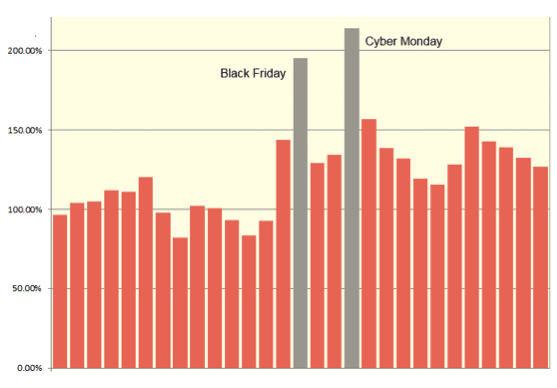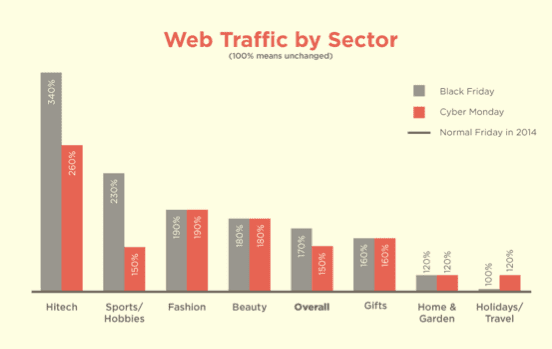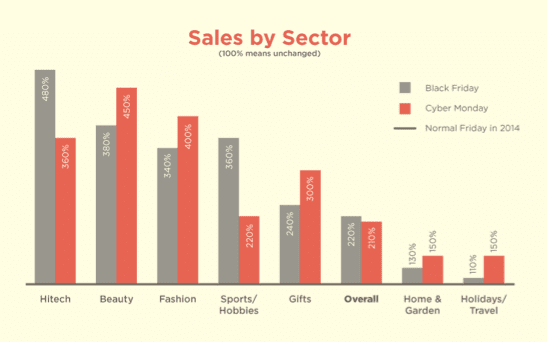Data shows uplift retailers in the UK and worldwide can expect from the key e-commerce dates this month
For retailers, the festive season effectively starts with Black Friday on 27th November 2015 and Cyber Monday three days later. This year some experts are predicting that UK sales could top the one billion pound mark. To understand what we should expect this year let’s take a look at how things panned out in 2014.
The data in the charts below is compiled by Fresh Relevance and the predicted uplift is based on billions of page views across retail websites in previous years (approx. 50% in the UK and 50% worldwide).
The impact of the two day shopping bonanza starts one week ahead of Black Friday as traffic falls back slightly, suggesting that consumers are delaying purchases in the anticipation of lower prices. Then the day before a 25% increase in traffic as shoppers’ scope out retail sites looking for details of pending offers and discounts.
Website traffic before during and after Black Friday and Cyber Monday

During Black Friday and Cyber Monday, traffic volumes explode with approximately 200% higher rates of traffic than normal with some sectors experience much higher increases. However, during the weekend in between traffic falls back but remain relatively high as consumers Christmas shopping season gets well underway.
As I explained for certain sectors traffic explodes, most notably technology retailers who experienced an increase of 340%, as well as sports, fashion and beauty, and in the main this extra traffic is largely reflected in extra sales. Meanwhile, sectors such as home & garden and holidays & travel experience much smaller increase by comparison, however, with sales up 130% and 110% on a typical Friday in 2014 it is not to be ignored.
Website traffic by sector

Online sales by sector

It is also interesting to observe how in some sectors such as fashion, beauty, gifts, home & garden and holidays & travel, sales are significantly higher on Cyber Monday than Black Friday, despite traffic volumes being relatively even. This is possibly due to consumers waiting for the best offers, or fearful that they may miss out by the time Tuesday morning comes around.
What does this mean for 2015?
It is likely that this year will break all previous records, so for those retailers who rely on the festive season to provide a large chunk of their annual revenues the incentive to get things right is huge.
Of course, Black Friday is only a few weeks away but there is still time to learning the lessons from the previous year and make changes that will help to drive traffic to your site and increase sales. Here are a few techniques used by some of the sites we monitored last year that could also help you.
Counting down in real-time
One technique that worked extremely well for retailers last year (in the run-up to and during the flash-sales) was the use of real-time countdown timers, both on the website and in outbound email messages.
Because these timers can be embedded in an email it means that whenever it is opened or reopened it only ever displays the up-to-date time until the beginning or end of the event. This can be especially useful given that Black Friday and Cyber Monday fall on working days of the week for most of us. For example, sending an email at 11am with a one hour countdown to a lunchtime promotion, or at 4pm before the rush-hour can be great way to entice visitors to the website, especially if it accompanied by other fresh and relevant content.
A queue is a sales opportunity
Another popular occurrence last year was the implementation of queuing systems in an attempt control the flow of traffic on to the site. Of course, it also works to create a sense of urgency in the mind of the visitor. If you have queued for 15 minutes (and as Brits we are ever so disciplined) you may have a higher predisposition to making a purchase, as well as making a quicker decision. Afterall, you don’t want to miss out, or go through the queuing process again for that matter. One ‘trick’ that retailers using these systems miss out on is using this time when you have a captive audience to push information and sell to them.
This isn’t a new idea, but implementing it in this way is. Organisations have been using this technique for many years, to engage with customers that wait in on-hold on the telephone. Using the same technique online makes perfect sense. Whilst they are waiting you can present information to them that will not only pass the time but also provide valuable information based on their personal preferences, what people are looking at and buying right now based on crowd-sourced data, new product-lines that will be available at the time they are given full access to the site, or stock updates to further entice or avoid disappointment. The list is exhaustive.
Rotate offers for returning customers
A Black Friday customer/ visitor may return again on Cyber Monday, so look at ways in which you can rotate your offers on the website to pique the interest of repeat and returning visitors.
Social proof
Also, be aware of the power of social proof and use this to your advantage, displaying what is trending on your site can encourage that spontaneous ‘I must have’ or ‘I know someone who would love that’ purchase.
Don’t forget your cart abandonment
As I said earlier, a one-day sale on a work day can present a challenge for would-be customers. Queuing to get access to the store and browsing can leave little room for getting through the checkout before the end of the lunchbreak. Cart abandonment rates can be expected to be higher on these two days due to the increased traffic. So, it stands to reason that if you can get your abandonment strategy right the recovered sales will also be greater. The ideal email will arrive within the hour of abandonment and will display the content of the basket (product images work better than plain text), availability information (or alternatives if out-of-stock), a countdown timer to when to place an order needs to be placed in order to meet a specific delivery date, and a link directly to the checkout that circumvents or places the customer at the front of the queue.
Sales time is the ideal time to grow your email marketing database
As the 2014 statistics clearly show, no matter what sector you are in you will inevitably see a spike in your website traffic. This makes it the ideal time to try and capture new information about visitors. Using pop-ups is a tried and tested way to encourage visitors to share their email address with you.
All of this can be realistically implemented, tested and perfected well in advance of the 27th November. It is looking to be the biggest spending online shopping weekend we have ever seen in the UK, and one of the most hard fought. Giving yourself even the smallest competitive edge could reap some of the biggest rewards.

Thanks to
Make Austin for sharing their advice and opinions in this post. Mike Austin is the CEO of
Fresh Relevance, a serial entrepreneur and technologist. He has been building software companies for over 20 years. During the 1990s Mike provided IT security consultancy to the UK financial sector and created some of the first PC mapping software. You can follow him/her on
Twitter or connect on
LinkedIn.






 Thanks to
Thanks to 



